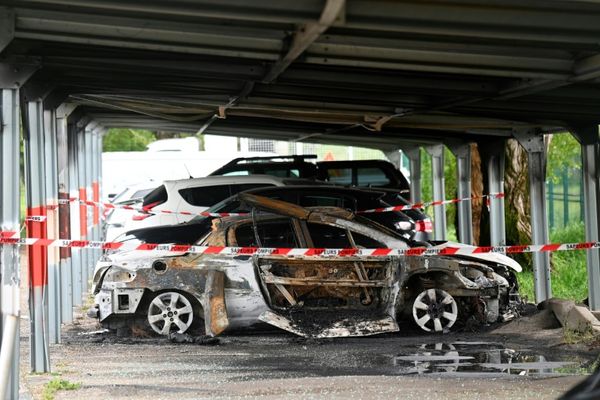
A door bursts open, a man hurtles across the screen, overturning a table in pursuit of some vanishing figure. A door bursts open, and a woman slams it hard against whoever is chasing behind her. A door opens more slowly, a face peering anxiously round it, eyes widening with astonishment. Just as you are about to see who or what they saw, the door closes with a click. A key turns sharply in the lock.
Swiss-American artist Christian Marclay’s Doors is all revelation and drama. For almost an hour, the viewer sits spellbound in a darkened cinema specially created for the film’s UK premiere at White Cube, watching a nonstop onslaught of entrances and exits. Clip after clip, selected from hundreds of movies, appears on the big screen in an extraordinary feat of choreography and collage. Somehow, it seems as if each is directly connected to the next, no matter that they shift between monochrome and colour, and all the way from silent films to French New Wave and Hollywood blockbuster.
Ingrid Bergman, Sidney Poitier, Bette Davis, Bill Murray – they arrive and they depart, every time through a door. John Wayne saunters in, with a searching look, Robert Mitchum rushes angrily through, John Travolta breaks out into the night through the exit.
Each door marks an edit point, and every edit is so deft that the actors always appear to be on their way to the very next scene. One door opens and a new film begins. Mia Farrow looks through a keyhole, in Rosemary’s Baby, and what she sees is a nightmare from a completely different movie. Rita Hayworth, in glamorous gown, goes to answer the door and it opens into another film.
A double locking of the door is shown in Hitchcockian closeup. Or a door being slyly locked with the use of a blade, so that it does not appear is if anyone’s broken in. A door swings open to reveal a gift left inside an apartment. It creaks, opens of its own accord, slams alarmingly shut. No actors are needed when the door has become the protagonist.
Suddenly you notice the same scene reappearing: perhaps this is where you came in, and Marclay’s film is beginning again? But then the scene turns out to be very slightly longer, offering fractionally more narrative, before it cedes to the next clip. This creates a pleasingly piquant unease for audiences used to watching art films on loop. For this is by no means the end.
Marclay (born 1955) is famous for his timing, specifically for 2010’s The Clock, featuring watches, clocks and characters reacting to them in thousands of collaged clips. That 24-hour wonderwork was synchronised to real time in the many museums where it was shown, so that when Robert De Niro checked his Rolex at 2.03pm, it really was 2.03pm. The viewer was outside time, watching the film, and yet positioned within it, always reminded of its ticking reality on the screen.
Those refined calculations extend to sound here too; each door opens into a new space and time, but also into a new soundscape. Heavy breathing merges into panting, dramatic music into screaming violins, which cross-fade with storms. You soon realise, too, that film-makers rarely show a door closing when they can imply it through sound instead.

Marclay’s film exceeds the encyclopedic labours of its own making in every respect. Even as it crystallises the role of doors in cinema – all the ways they are used to begin or end a scene, to ratchet suspense, or orchestrate rhythm – so it builds into its own self-contained movie per se. Ten years in the making, its own rhythm is so subtle it seems to press forwards in perpetuity. The door never shuts, you might say.
Marclay is a terrific manipulator of emotion and tension. His film moves through the ominous arrival of the doctor at the bedside or the lawyer at the prison cell, from the awful tension of a gradually opening door to the urgent wait for the lift doors to part with a view of safety (or its opposite) for a fleeing figure. Every clip is perfectly choreographed, and timed, to sustain our never-ending sense of anticipation.
This exhibition also includes a series of new sculptures constructed from old doors. A door gnawed away to its frame, without panels or fittings: the ghost of a door, as it seems, or has it now become a window? An infinite column of lock panels that rises to the ceiling. The central architecture of a door, cut to a cross shape, so that it becomes a crucifix, the knocker where a human head might be.
Best of all, in these “alterations”, as Marclay modestly calls them, is a horizontal stack of doors with fractional gaps between them. The irresistible impulse is to kneel down and peer through, like the child you have just seen in Marclay’s film, trying to understand the world by looking through a letterbox.

Which is, in the end, what this marvellous show is about: not just doors in films, or even doors in reality, but the curious role of these curious and intermediary objects in our existence. Doors become newly emblematic in Marclay’s art. They speak of everyone who might come or go through them, every before and after, everything seen and unseen in some scenario or story. Above all, they stand for our constant desire to know what happens next.
• Christian Marclay: Doors is at White Cube Mason’s Yard, London, until 30 September







